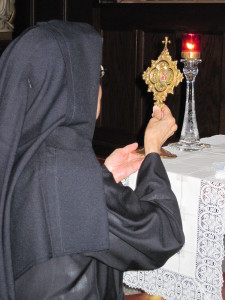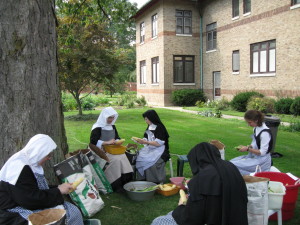In this Year of Consecrated Life, we continue the account of our foundation as told in our “Mission and Spirit.”
The Original Plan (from “Mission and Spirit”)
 Why this foundation? St Francis de Sales has often himself explained it: “The plan is to give God Daughters of prayer, and souls so interior, that they may be found worthy to serve His Infinite majesty and to adore Him in spirit and in truth. The great Orders already established in the Church may be left to honor our Lord by excellent spiritual exercises and striking virtues, but all I want for my Daughters is that they should try to glorify Him by their lowliness; . . .”
Why this foundation? St Francis de Sales has often himself explained it: “The plan is to give God Daughters of prayer, and souls so interior, that they may be found worthy to serve His Infinite majesty and to adore Him in spirit and in truth. The great Orders already established in the Church may be left to honor our Lord by excellent spiritual exercises and striking virtues, but all I want for my Daughters is that they should try to glorify Him by their lowliness; . . .”
“. . . so as to follow Our Lord more readily, more freely and more favorably , hearing the voice of the One who calls them to follow, they leave all things, like the Apostles, clinging to one thing only – to please God and follow Him , not wanting their heart to be divided and distracted by many different things, but simply and whole-heartedly to seek the unity of a sole and single minded love of God”.
There will be no solemn vows in this little assembly but very great inner perfection. (This would change with the first foundation made in Moulins after which the congregation was  erected into a regular Order with solemn vows and papal enclosure.)
erected into a regular Order with solemn vows and papal enclosure.)
“. . . as this Congregation will not have great austerity, nor yet bonds from which the Sisters cannot be released, as is the case of formal or regular Congregations, the fervor of charity and the force of a very firmly held inner determination must supply for all that, and take the place of laws, vows and jurisdiction, so that this Congregation may demonstrate the truth of the Apostle’s words, that the bond of charity is the bond of perfection”.
From 1st July 1610, St. Francis wanted his little Congregation to be called: The Visitation of Our Lady, or Religious of the Visitation of Holy Mary, “because”, as he said , “he found in it very many spiritual facets which filled his mind with special light about the spirit he wanted to establish in his Institute”.
“. . . because it was a hidden mystery and was not given solemn celebration in the Church as were others, it would at least be given a special place in our Congregation”.
According to his particular genius, which was firmly to leave beaten tracks and to keep his eye only on essentials, St. Francis de Sales was trying out an experiment of the kind which made him publish The Introduction to the Devout Life. After he had put a deeply Christian life within the reach of all, he opened up the doors of an authentic religious life to every soul called to it by God:
 “It often happens that girls and women with a true vocation want to enter religious life , but either because of their health or their age, or simply because they are not drawn to austerities and external rigor, find that they cannot enter orders where considerable physical penance is the rule . . .”. And so that souls of this kind should in future find some assured retreat in this part of the country, our Congregation has been designed in such a way that no great rigor should prevent those who are not strong and robust from joining it and pursuing the perfection of divine love”.
“It often happens that girls and women with a true vocation want to enter religious life , but either because of their health or their age, or simply because they are not drawn to austerities and external rigor, find that they cannot enter orders where considerable physical penance is the rule . . .”. And so that souls of this kind should in future find some assured retreat in this part of the country, our Congregation has been designed in such a way that no great rigor should prevent those who are not strong and robust from joining it and pursuing the perfection of divine love”.
“Two things are needed if women of this kind are to be given a positive vote: firstly, they must be people really called by God ; secondly, they must have the conditions laid down for our manner of life . . . A good vocation is, in fact, a firm and steady will on the part of the person called , that she wants to serve God in the manner and in the place to which His divine Majesty is calling her”.
This is how Father de Villars, SJ. expresses his approbation when writing to the Founder:
“It seems to me, Monseigneur, that there is still a definite need in the Church for this Congregation and that God has raised you up in our day to make this foundation. Our Lord has indeed visited his people, and it looks as though the blessing of this beginning will extend ever more widely with a great increase in numbers: for surely , the less robust needed a middle way, widows a moderate approach, and the hardy and fervent can well do with this kind of mortification”.